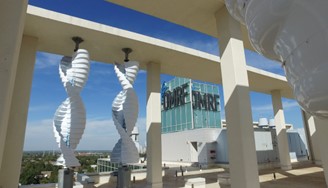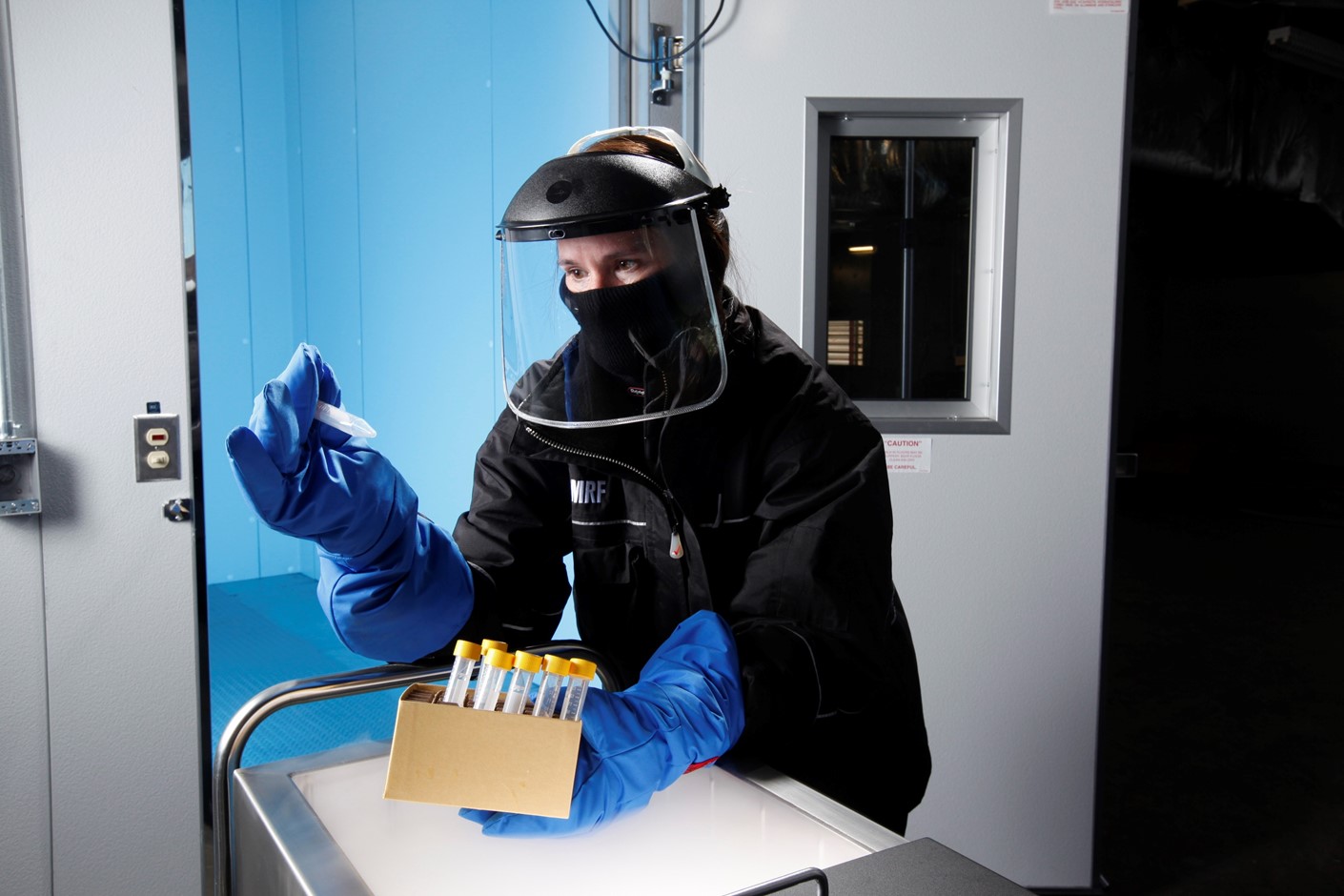Oklahoma Medical Research Foundation Construction Supports Inclusive Immunology Research and Proactive Initiatives

The Oklahoma Medical Research Foundation (OMRF) has been working toward a more inclusive, collaborative future by supporting research and training focused on underrepresented minorities, environmentally conscious architecture (Figure 1), and forward-thinking scientific initiatives. Funding from three ORIP construction grants (C06RR014570, C06RR017446, and C06RR030593) supported renovations to facilities for research in molecular immunology and genetics, cardiovascular biology, and autoimmune diseases. Grant C06RR030593 was administered through the 2009 American Recovery and Reinvestment Act (ARRA) grant program, which aimed to stimulate the U.S. economy, create and preserve jobs, and advance scientific research. With this funding, OMRF has been able to expand the breadth of its research, recruit exceptional scientists and trainees, and foster exciting collaborations across Oklahoma and the nation.
Funds from ORIP supported three construction projects: (1) renovation of an existing building to provide modern, safe laboratory facilities; (2) conversion of outpatient and mechanical spaces into new laboratory and clinical spaces; and (3) construction of a new multidisciplinary laboratory and clinical space with an associated cryo-storage facility. These renovations improved clinical care, allowed OMRF to expand and strengthen its clinical research infrastructure, stimulated advancements across OMRF’s research continuum, and led to a dramatic growth in collaborations and grants. OMRF’s economic impact studies confirmed that research conducted in these facilities enabled investigators to acquire funding for additional research and added significant income and jobs to the community. “These grants have been incredibly key in helping us recruit and retain really bright individuals and being able to enhance the reach to our patient populations, clinical staff, and scientists,” said Dr. Judith James, Executive Vice President and Chief Medical Officer of OMRF and Professor and Program Chair of the Arthritis & Clinical Immunology Research Program. “They have been crucial in bringing together different types of scientists and helped us think about the really pivotal questions that will improve the lives of patients.”
Many autoimmune diseases disproportionately affect women, and some conditions—including systemic lupus, erythematosus, Sjogren’s syndrome, and rheumatoid arthritis—are more prevalent and more severe in people with African American, Latinx, and American Indian/Alaska Native (AI/AN) heritage. Many of the programs in the upgraded areas address the differences in outcomes for patients from underrepresented minority communities. With the integration of research and clinical space, OMRF also has increased its focus on strengthening connections among clinicians, researchers, and patients. “It’s been really motivational for our basic scientists to meet some of the patients and see how impactful the disease they’re studying is on the lives of patients and their families,” Dr. James said. “They can see that their discoveries may be insightful for future patients who will benefit from NIH-funded research.”
One particular focus area has been Native American health and partnerships with local Tribes. “This is a passion of mine, and also of the institution,” Dr. James said. OMRF has been involved in the NIH-funded Native American Research Centers for Health (NARCH) grants, which are awarded to several Tribes in the region. Additionally, NARCH has partnered with OMRF for more than 16 years to help focus OMRF’s research on questions that are meaningful to Tribal communities. Standard blood biomarkers often are less predictive for the Oklahoma Tribal citizens; as a result of this partnership, OMRF and Tribal clinicians were able to identify better blood markers for the Oklahoma Tribal citizens and change the way that rheumatic diseases are screened for. OMRF and NARCH awardees also have been working to understand the mechanisms of accelerated molecular aging in Tribal populations and find ways to address the lower life expectancy of Native populations. OMRF and partnering Tribes have coordinated an exchange of knowledge, with staff physicians working closely with members of Tribal nations and Tribal clinical coordinators receiving specialized training at OMRF. In addition, the OMRF team worked collaboratively with Tribes in responding to the COVID-19 pandemic.
OMRF also provides training and education opportunities for students from underrepresented research backgrounds. Through collaborations with NARCH awards, more than 20 undergraduate students with AI/AN citizenship or heritage have conducted research at OMRF focused on autoimmune diseases, immunology, inflammation, or molecular biology, with some focusing on immune responses that are dysfunctional in AI/AN populations. Former trainees have found careers in medicine and academia, including several who focus their work on osteoarthritis, which affects AI/AN populations disproportionately and causes significant disability in AI/AN individuals. OMRF hosts summer undergraduate research fellows from Langston University, a historically Black university, who can then gain experience working in NIH-funded laboratories, including those in the renovated space. Students interested in continuing their project through the next school year are supported by adjunct faculty members at Langston University. This program supports mostly Black-identifying students, but many participants are members of Tribal nations as well.

In addition to the renovated laboratory and clinical space funded by the construction grants, usable space within the mechanical floor of OMRF’s new research tower was developed into a centralized long-term cryo-storage facility to house and protect large collections of patient samples (Figure 2). This biorepository highlights OMRF’s scientific capability and would not have been possible without the funding provided by the ORIP grant. The grant allowed the opportunity to consolidate and expand OMRF’s existing biorepositories and improve the data systems required to support state-of-the-art research. It is now one of the largest −80°C biorepositories in the world, and many collaborators throughout the nation use its resources. “It’s really been transformational,” said Dr. James. “It’s allowed us to be able to become a centralized biorepository for many different kinds of collaborative grants that we would not have been able to do otherwise.” The biorepository also allowed OMRF to continue expanding its collaborations with local Tribes, and OMRF staff have helped Tribal Nations develop their own repositories.
One particularly unique aspect of the research tower is its environmentally conscious design. The facility is Leadership in Energy and Environmental Design (LEED) Gold certified; features include a state-of-the-art HVAC system, natural sunlight, reduced water usage, wind turbines, active chilled-beam units, and linoleum composition floor tiles from rapidly renewable resources. “When we first started the building, that was a very unique and new idea in the United States and in Oklahoma,” Dr. James said. “It changed how we think about our buildings.” OMRF’s architectural partner designed wind turbines in the shape of DNA double helices to capture Oklahoma’s famous “wind that comes sweeping down the plains” and use it to power the facilities. The landscaping includes native grasses, water collection systems, and features that change depending on weather and rainfall, making the OMRF campus a harmonious part of the local landscape, as well as a memorable landmark (Figure 1).
This forward-thinking architectural design, combined with the multidisciplinary scientific opportunities available to researchers and the thoughtful integration of community and patient collaborations, “definitely helps us with recruiting and retention, and it helps bring everyone together with this common goal of being better stewards,” Dr. James said. Many OMRF research staff, including core directors and associate directors of the National Institute of General Medical Sciences–funded Oklahoma Shared Clinical and Translational Resources U54, are from Tribal Nations. “We’ve been very, very appreciative of these ORIP grants because they’ve helped us leverage other kinds of funding to build things we didn’t know were possible,” Dr. James said. “They’ve also helped us forge collaborative networks of scientists and build collaborations with some amazing partners throughout Oklahoma and across the nation, and we hope this happens with every construction project.”
Visit ORIP’s website for more information on the ARRA program and awards.



